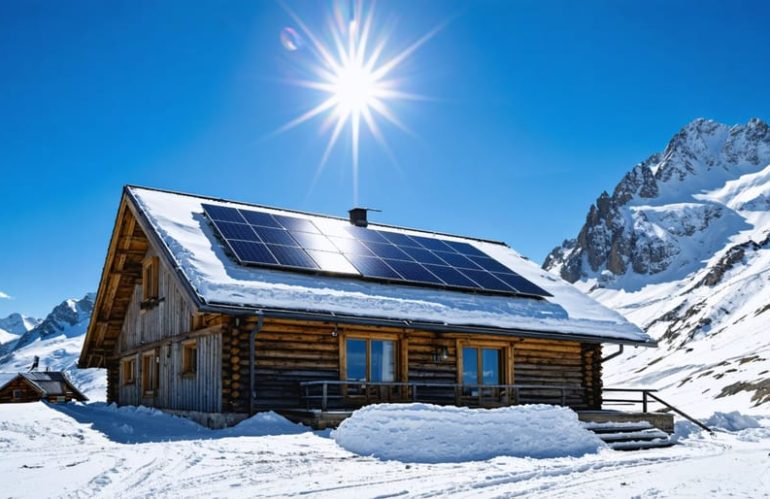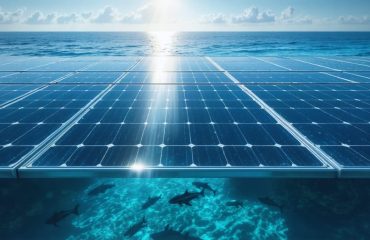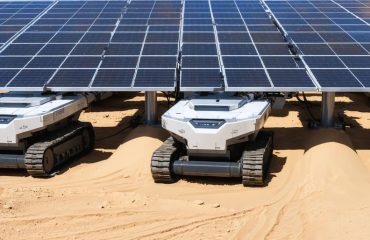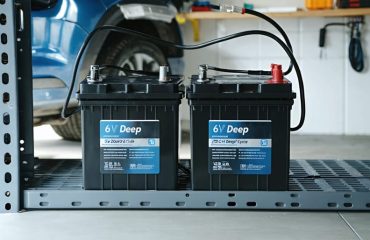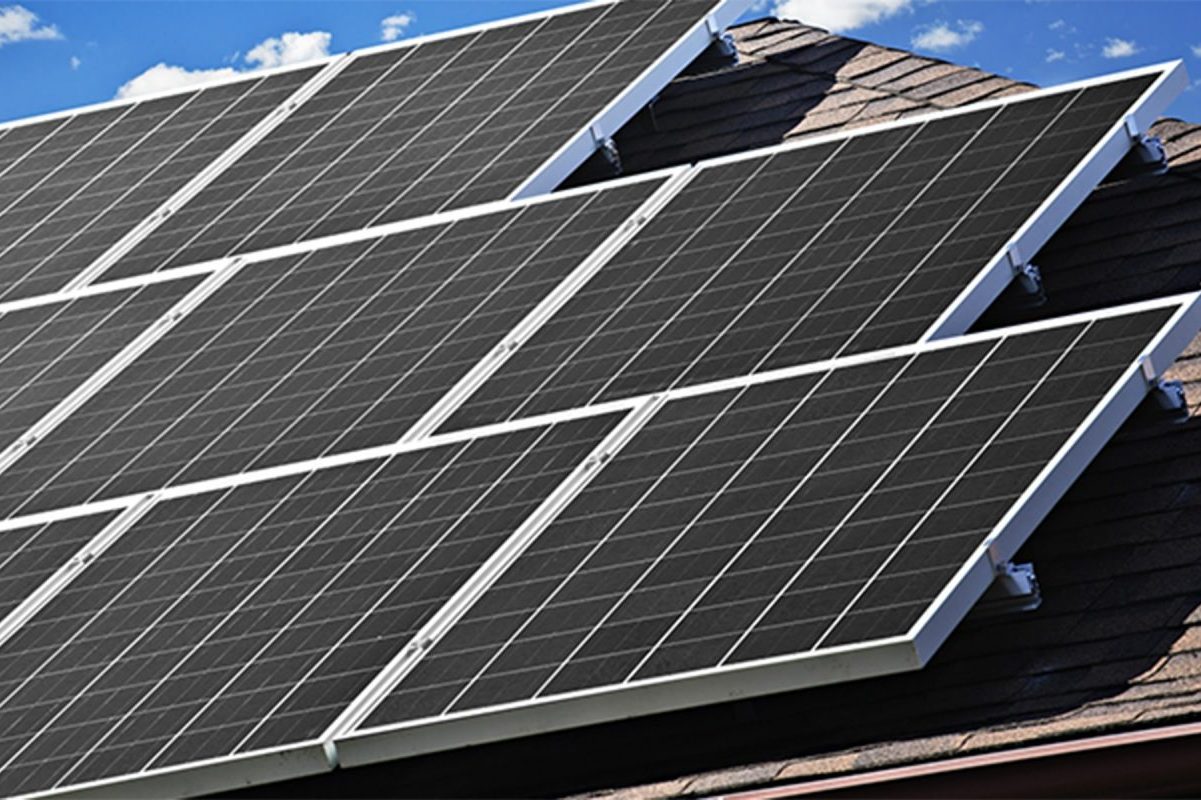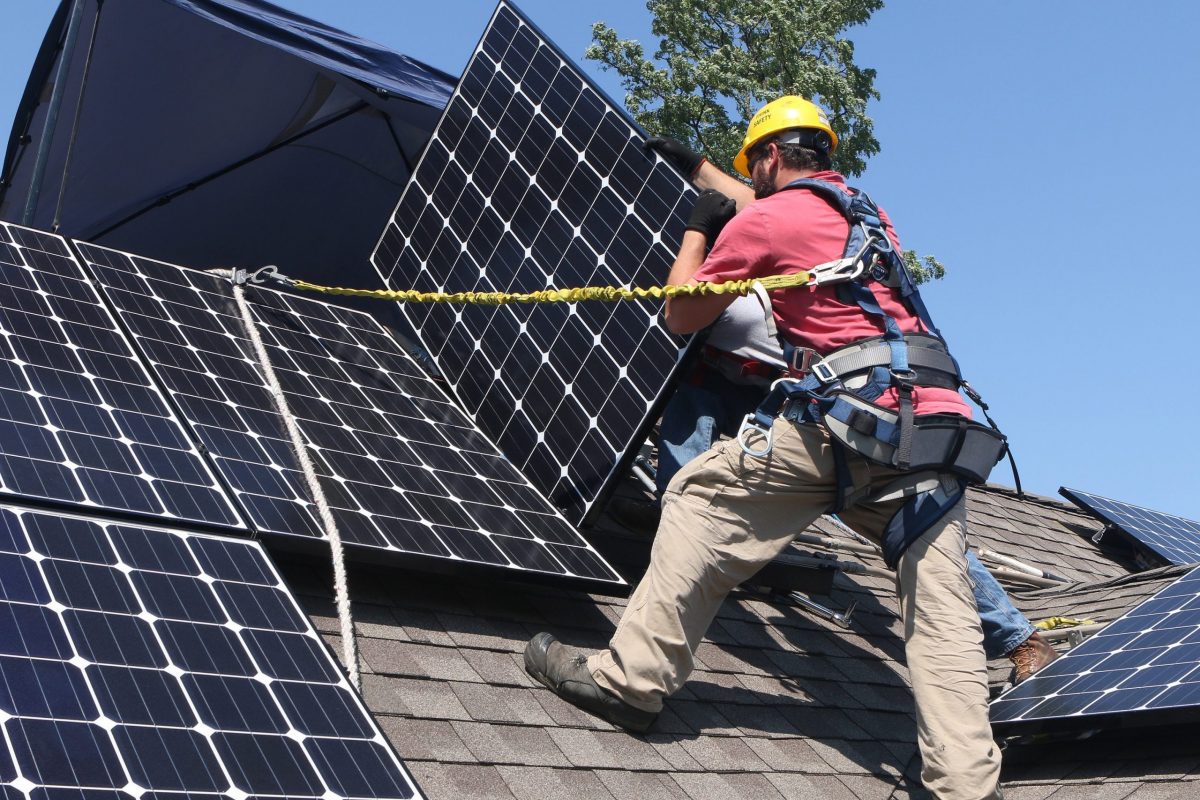Harness the unique advantages of mountain solar installations to achieve energy independence while maximizing your home’s natural elevation and exposure. Despite challenging extreme weather conditions, mountain properties often receive more direct sunlight and cooler temperatures – ideal factors that boost solar panel efficiency by 10-15% compared to lower elevations. Higher altitudes mean clearer skies and less atmospheric interference, allowing mountain homeowners to generate more power with fewer panels. The growing availability of specialized mounting systems designed for steep roofs and snow loads has transformed previously challenging installations into straightforward projects with compelling returns on investment. Modern solar technology, combined with smart positioning strategies, now enables mountain homes to harness renewable energy year-round, often producing surplus power during peak summer months to offset winter usage. Whether you’re looking to reduce your carbon footprint or cut energy costs in a remote location, mountain solar installations offer a reliable, sustainable solution that capitalizes on your property’s natural advantages.
Why Mountain Homes Are Perfect for Solar Power
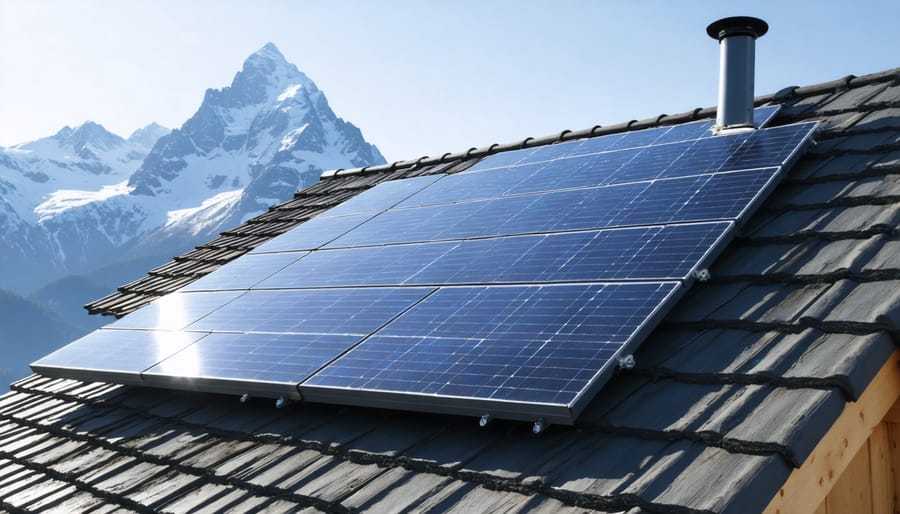
Higher Sun Exposure at Altitude
One of the most significant advantages of mountain living for solar power is the increased solar exposure at higher elevations. As you climb in altitude, there’s less atmosphere for sunlight to travel through, which means more direct solar radiation reaches your panels. For every 1,000 feet of elevation gain, solar radiation increases by approximately 1.5%.
Mountain locations also tend to experience fewer obstacles between the sun and solar panels. The thinner air contains less pollution, dust, and water vapor that typically scatter or absorb sunlight at lower elevations. This clearer atmosphere allows more intense sunlight to reach your panels, potentially increasing their efficiency.
Additionally, mountain areas often rise above morning fog and low-lying clouds that can block sunlight in valleys and lowlands. This means your panels might receive more hours of direct sunlight throughout the day, even during seasons when valley locations experience persistent cloud cover.
While temperature drops at higher elevations might seem concerning, the cooler mountain air actually helps solar panels operate more efficiently, as they perform better in cooler conditions.
Natural Snow Reflection Benefits
One of the hidden advantages of installing solar panels in mountainous regions is the natural boost in efficiency from snow reflection. Known as the “albedo effect,” snow can reflect up to 90% of the sunlight that hits it, effectively creating a natural mirror that directs additional solar energy toward your panels. This reflection can increase your system’s energy production by 15-30% during winter months, helping to offset any reduced output from shorter daylight hours.
Even when snow covers the ground, your panels can still capture this reflected light, making mountain locations surprisingly efficient for solar power generation. The combination of higher elevation (which means clearer air and stronger sunlight) and snow reflection creates ideal conditions for solar energy production. This natural enhancement is particularly beneficial during clear, sunny winter days when the snow is fresh and highly reflective.
For homeowners in mountain regions, this means you’re not just getting direct sunlight – you’re also capturing reflected light that would otherwise go unused, maximizing your investment in solar technology.
Special Considerations for Alpine Solar Installations
Snow Load Engineering
Installing solar panels in mountain regions requires special consideration for snow loads, but modern mounting solutions make it completely manageable. The key lies in robust racking systems designed to withstand significant weight and specialized mounting techniques that keep panels secure year-round.
Most mountain solar installations use heavy-duty aluminum rails mounted at steeper angles, typically between 35-45 degrees. This steeper pitch serves two purposes: it optimizes sun exposure during winter months and helps snow slide off naturally. The mounting hardware includes reinforced brackets and additional support points to distribute weight evenly across the roof structure.
To handle extreme snow loads, installers often add extra rail supports between standard mounting points, creating a stronger foundation. High-grade stainless steel bolts and nuts are used to prevent corrosion and maintain structural integrity through freeze-thaw cycles. Many systems also incorporate snow guards above the panels to prevent dangerous snow slides while allowing controlled melting.
The mounting system’s design accounts for both dead loads (the weight of the equipment) and live loads (snow, wind, and ice). Professional installers calculate these factors using local building codes and historical weather data to ensure your system exceeds safety requirements. Some mountain installations even feature adjustable mounts that can be tilted further during heavy snow seasons for better snow shedding.
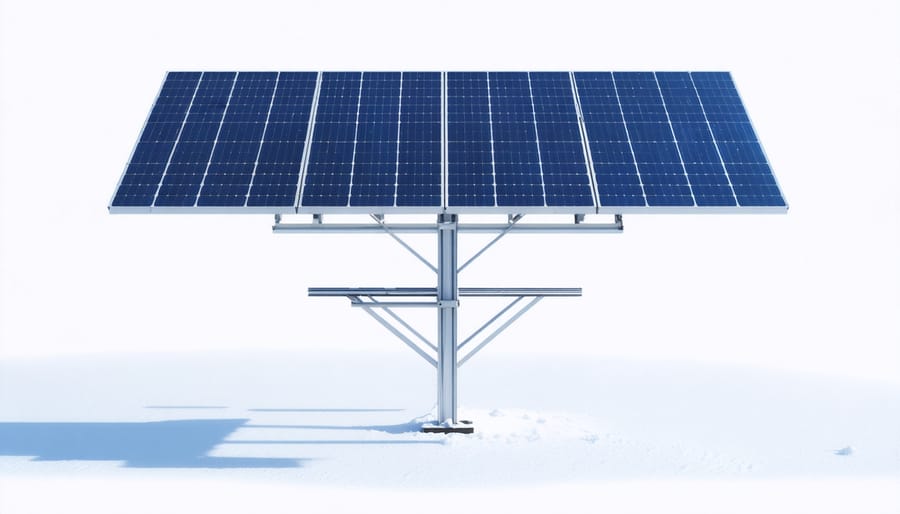
Cold Weather Performance
Contrary to common belief, solar panels actually perform exceptionally well in cold mountain climates. While many assume that sunny, warm locations are ideal for solar power, the temperature effects on solar efficiency show that panels are more productive in cooler conditions. This is because solar panels use light, not heat, to generate electricity, and the cold temperatures help prevent power loss from overheating.
In mountain environments, panels typically maintain peak efficiency during winter months, often operating at 15-25% higher efficiency compared to warm weather performance. The crisp mountain air and high altitude mean less atmospheric interference, allowing more direct sunlight to reach the panels. Additionally, sunlight reflection from snow can boost energy production by up to 30% on clear winter days.
Modern solar panels are engineered to withstand extreme cold, with most rated to perform reliably in temperatures as low as -40°F (-40°C). The key is proper installation, including reinforced mounting systems designed for snow loads and optimal panel angles that help shed snow naturally. Some systems even include snow guards or heating elements to prevent excessive snow accumulation, ensuring consistent performance throughout the winter months.
Best Solar Panel Types for Mountain Homes
High-Efficiency Monocrystalline Panels
When it comes to mountain solar installations, high-efficiency monocrystalline panels offer exceptional performance that makes them ideal for elevated locations. These premium panels excel in harsh environmental conditions, converting more sunlight into electricity even during shorter winter days or partially cloudy weather.
Their superior efficiency means you’ll need fewer panels to meet your energy needs, which is particularly valuable when working with limited roof space on mountain homes. Monocrystalline panels also perform better in cold temperatures, actually increasing their efficiency as temperatures drop – a natural advantage for high-altitude installations.
These panels are built to withstand heavy snow loads and extreme temperature fluctuations common in mountain environments. Their robust construction features reinforced frames and tempered glass that can handle substantial weight and impact from winter precipitation. The smooth surface of monocrystalline panels also helps snow slide off more easily, reducing maintenance needs and ensuring consistent energy production throughout the winter months.
The initial investment in high-efficiency panels typically pays off faster in mountain settings, where their enhanced performance and durability translate to more reliable energy generation and lower long-term maintenance costs.
Bifacial Panel Advantages
One of the most exciting innovations in mountain solar installations is the use of bifacial panels, which capture sunlight from both sides. These double-sided panels are particularly effective in snowy mountain environments, where they can harness up to 30% more energy than traditional panels. When sunlight hits snow, it reflects upward and reaches the panels’ undersides, creating a unique opportunity for increased energy production.
This snow reflection, known as the albedo effect, gives mountain homeowners a special advantage. During winter months, when traditional solar installations might see decreased output, bifacial panels continue to perform impressively by capturing both direct sunlight and reflected light from the snow-covered ground. The bright white surface of snow can reflect up to 80% of the sunlight that hits it, making it an excellent natural mirror for your solar panels.
The benefits extend beyond winter too. Mountain installations often have elevated mounting systems to handle snow loads, which creates an ideal setup for bifacial panels. This elevation allows light to bounce off the ground and reach the panels’ undersides year-round, maximizing energy production in all seasons. For mountain homeowners, this means more consistent energy generation and better return on investment throughout the year.
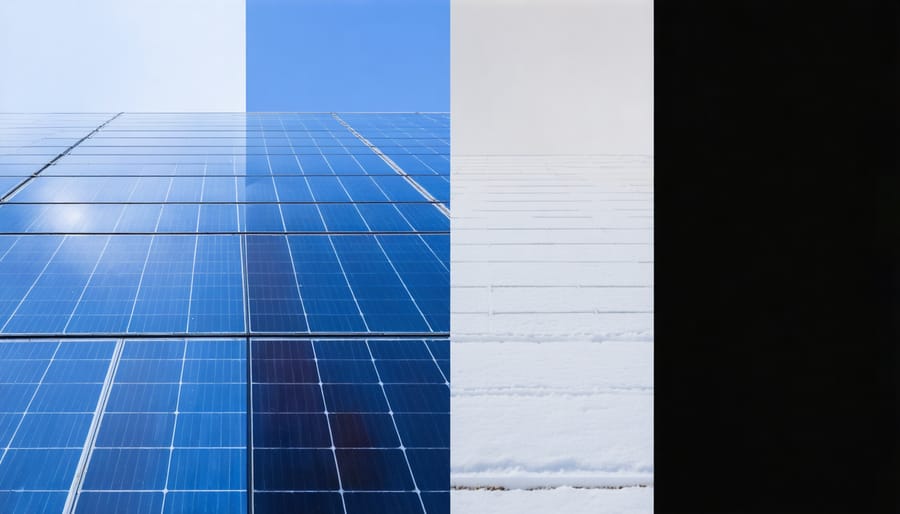
Maintenance Tips for Mountain Solar Systems
Snow Removal Strategies
Effective snow management is crucial for maintaining your mountain solar system’s performance during winter months. The good news is that most solar panels are designed to handle snow loads, and there are several proven methods to keep them functioning optimally.
The simplest approach is to let nature do the work. Solar panels are typically installed at an angle, allowing snow to slide off naturally as temperatures rise. This passive method is often sufficient, especially with panels installed at steeper angles common in mountain installations.
For active snow removal, use a soft-bristled snow rake with an extended handle to gently clear snow from your panels. Never use metal tools or sharp objects, as these can damage the panel surface. It’s also important to clear snow from the bottom edge first, working your way up to prevent snow buildup at the panel’s base.
Some homeowners opt for heating elements or snow-melt systems specifically designed for solar installations. While these systems require additional investment, they can provide automatic snow removal and maintain consistent energy production throughout winter months.
Remember to prioritize safety – if you’re uncomfortable accessing your roof during winter conditions, contact a professional solar maintenance service for snow removal.
Seasonal Maintenance Schedule
Maintaining a mountain solar system requires a seasonal approach to ensure optimal performance throughout the year. In spring, schedule a thorough inspection after winter to check for any damage from snow loads or ice. Clean panels of winter debris and verify all mounting hardware remains secure. This is also the perfect time to trim back any vegetation that may have grown during the previous season.
Summer maintenance focuses on maximizing energy production during peak sunlight hours. Regular panel cleaning becomes especially important due to increased dust and pollen. Monitor system performance closely, as summer typically offers the highest energy generation potential.
Fall preparation is crucial for the approaching winter. Clear gutters and drainage systems to prevent ice dam formation, and ensure all panel angles are optimized for winter sun exposure. Check all weatherproofing seals and repair if necessary.
Winter requires vigilance in snow management. While many mountain solar systems are self-clearing due to steep angles, occasional manual snow removal may be necessary after heavy storms. Monitor system performance through your inverter dashboard to ensure panels are functioning efficiently despite reduced daylight hours.
Consider scheduling professional inspections twice yearly, ideally in spring and fall, to maintain peak system efficiency and catch any potential issues early.
Mountain solar installations represent a powerful opportunity to harness clean energy while making the most of high-altitude advantages. As we’ve explored throughout this article, while mountain locations present unique challenges, they also offer distinct benefits that can make solar installations particularly effective. The combination of clearer air, cooler temperatures, and often unobstructed sun exposure can lead to enhanced system performance and greater energy production.
For homeowners in mountainous regions, solar power isn’t just an environmental choice – it’s a smart investment that can provide significant returns through reduced energy bills and potential tax incentives. The key to success lies in proper planning, choosing the right equipment, and working with experienced installers who understand mountain-specific considerations.
Remember that while initial challenges like snow management and installation logistics require careful consideration, these obstacles are far from insurmountable. Modern solar technology and installation techniques have evolved to address these specific challenges effectively.
By taking action now, you can join the growing community of mountain homeowners who are leading the way in sustainable energy adoption. Whether your motivation is environmental stewardship, energy independence, or financial savings, mountain solar installations offer a viable and rewarding path forward.
Contact local solar installers with mountain experience to begin your journey toward energy independence. With proper planning and expert guidance, your mountain home can become a model of sustainable living while providing reliable, clean energy for years to come.

